Genus Thomomys Rank Species | Phylum Chordata Family Geomyidae Scientific name Thomomys mazama | |
 | ||
Higher classification Smooth-toothed pocket gopher Similar Gopher, Smooth‑toothed pocket gopher, Northern pocket gopher, Mammal, Rodent | ||
Mazama pocket gopher in his tunnel
The Mazama pocket gopher (Thomomys mazama) is a smooth-toothed pocket gopher restricted to the Pacific Northwest. The species ranges from coastal Washington, through Oregon, and into north-central California.
Contents
- Mazama pocket gopher in his tunnel
- Description
- Ecology
- Distribution
- Washington
- Conservation status
- Control
- Taxonomy
- Subspecies
- References
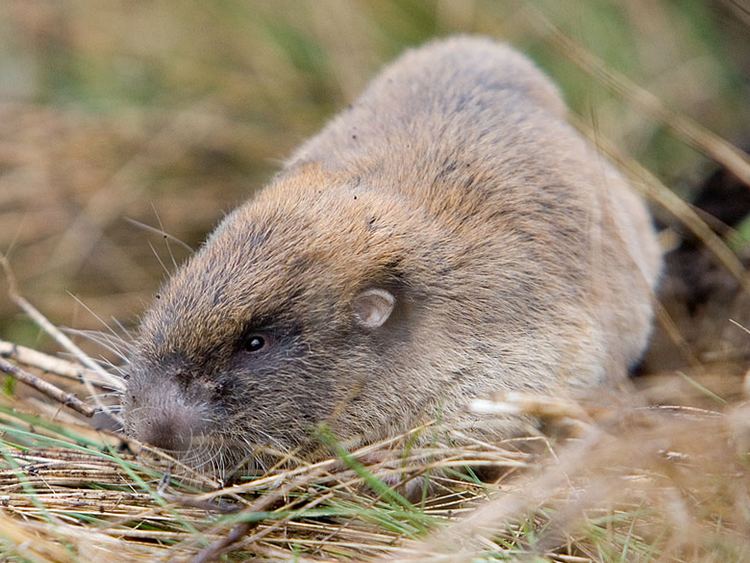
Description
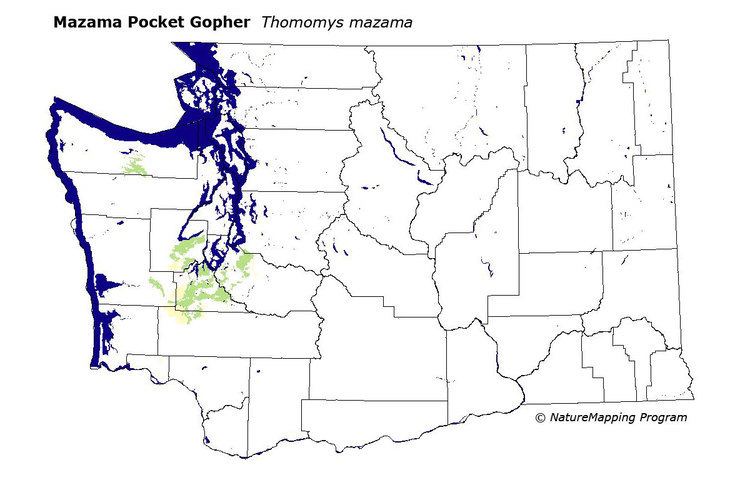
Mazama pocket gophers are light brown to black in color, with adults ranging in size from 5 to 6 inches in length. The species has poor vision, but excels as digging burrows with their long claws and strong limbs. The gophers transport food and nesting material by fur pouches on their bodies. The gopher's diet consists of plant material, mostly vegetation, roots and tubers. The gophers exhibit asocial behaviors except during the mating season. Mating is believed to be polygamous. Gestation lasts around 18 days, with each litter averaging 3 or 4 young. Females will usually have one litter per year between March and June.
Ecology
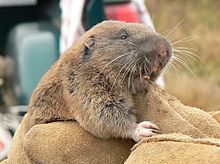
The Mazama pocket gopher is important to the prairie ecosystem in which it inhabits. Each gopher is capable of turning over 3-7 tons of soil per acre per year. Their presence is beneficial for plant diversity, with one study showing 5-48% higher as a result. The gopher burrows are utilized by many frogs, toads, small mammals and lizards.
Distribution
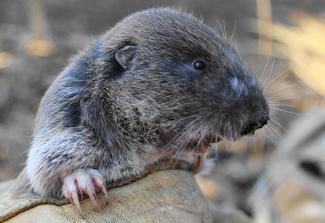
The total population is unknown, but believed to exceed 100,000, a majority of population resides in the state of Oregon. There are 27 known populations in the state of Washington, with an estimated 2000-5000 individuals total. The state of Washington has listed the Mazama pocket gopher and its subspecies found in the Puget Sound area as threatened.
Washington
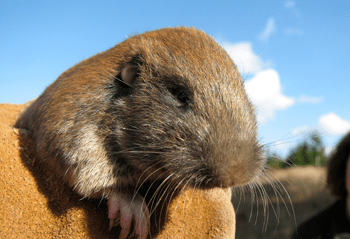
The Mazama pocket gopher in Washington has suffered habitat loss, with the remaining habitats being located in unexpected places. The largest populations have been found to reside around Fort Lewis and several regional airports. The Olympic National Park cited as another possible location for a sizable population.
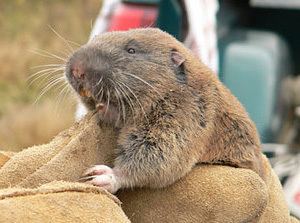
A 2005 study reported 6000 gophers living around Olympia airport, but this study has been criticized for its conclusions. The study made count of burrows and did not engage in trapping and marking to estimate the actual number of gophers present. The population is also known to vary erratically, increasing dramatically after the mating season and declining as the year progresses due to predation. This contradicts the estimated population listed on the IUCN database which lists between 2000-5000 gophers in the state of Washington with the isolated populations being representative of all 27 populations. The population of the subspecies indigenous to the area is unknown, with two of the sub-species presumed extinct and Thomomys mazama douglasii's status being uncertain and possibly extinct.
Conservation status
The species is currently listed as threatened by the state of Washington. In December 2012, a proposal was made by the U.S. Fish and Wildlife Service to list the gopher as threatened. It would apply to the four local subspecies of the Mazama pocket gopher and their prairie habitat. Their prairie habitat in which the gophers live has been reduced by 90-95% in the last 150 years. A translocation project has been undertaken, but a mortality of 90% has been reported.
The gopher is also listed as a pest in the state of Washington because it is known to cause damage to infrastructure. The gophers can destroy waterlines, endanger livestock, destroy crops and weaken levees and dams.
The conservation of the species has been met with some press coverage. In July 2013, Fox News ran a story about Fort Lewis's $3.5 million grant from the state of Washington to purchase 2600 acres of land during a time when workers were on furlough. Prior to this story, the grant was described by Interior Secretary Sally Jewell as "...taking an important step in addressing one of the greatest threats to wildlife in America today, loss of habitat, while helping to ensure the preservation of working landscapes and our military readiness."
Control
The gophers are known cause damage to farms and infrastructure through burrowing or consuming vegetation. Mitigating damage can be done by installing a gopher fence, which has to be at least 6 inches above ground and go down to a depth of over 2 feet or until bedrock or hardpan is struck. This fence is considered a temporary and not permanent defense against the gophers. Gophers are unlikely to be deterred by frightening devices like vibrating stakes, pinwheels and other sound devices. While other methods of control exist, the state of Washington's listing of the species as threatened limits the control to non-lethal actions.
Taxonomy
The Mazama pocket gopher takes its name from Mount Mazama, the ancient volcano that exploded to form Crater Lake in Oregon, where the species was first found. Despite its name, it does not appear in Mazama, Washington.
Subspecies
Subspecies of the Mazama pocket gopher include:
